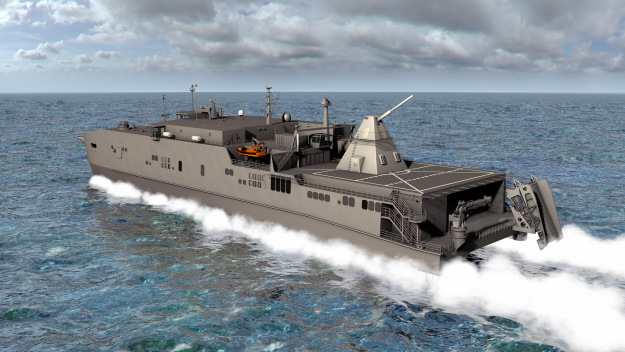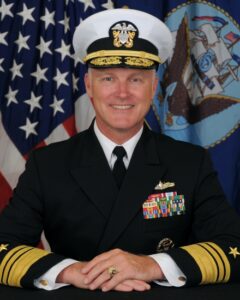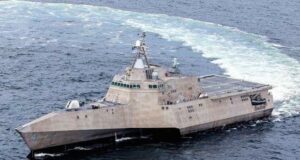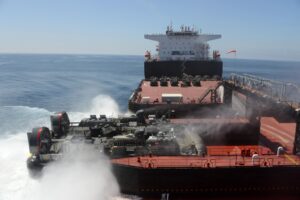Navy’s Distributed Lethality Will Reshape Fleet
Posted on
The Navy’s Surface Warfare leaders announced a new warfighting concept, Distributed Lethality (DL) nine months ago at the January 2015 Surface Navy Association symposium in Arlington, Va., and outlined it in the U.S. Naval Institute magazine Proceedings. DL is an innovative concept for how surface, amphibious and combat logistics ships can enhance the Surface Navy’s offensive “punch” in support of the nation’s maritime, military and national security strategies.
“Our vision,” Vice Adm. Thomas Rowden, Pacific Fleet commander of naval surface forces, said, “is of naval forces employed in a widely dispersed, often autonomous manner with the ability to hold potential adversaries at risk, at range.”
That will greatly complicate our opponents lives, Rowden said, “confusing their intelligence-surveillance-reconnaissance [ISR] capabilities and diluting their weapons-planning and targeting.”
But it’s Not a Strategy
Distributed Lethality is not a new strategy. Rather, it is a “unifying principle,” a Concept of Operations according to Admiral Rowden. “When fully realized, our vision will provide commanders a wider variety of effective and combat-credible power by increasing the offensive lethality of surface forces. Employing ‘adaptable force packages,’ these forces will hinder, prevent, disrupt or defeat increasingly capable, advanced adversaries.”
The DL concept addresses increasing the offensive firepower and lethality of the entire surface fleet—cruisers, destroyers, LCSs, future frigates, amphibious ships, and even replenishment ships. When combined with the expanding geographical distribution of U.S. naval surface forces and allied/partner navies, DL should dramatically expand the Navy’s capability to complicate adversary planning and to put at risk — if not outright destroy — enemy naval forces.
The DL concept looks to shift the surface force from a primarily defensive, sea-control posture to an offensive one that complements and enhances the larger Navy, including carriers, in power-projection missions. Indeed, offensively orientated cruisers, destroyers, LCSs and future frigates are at the core of a return to offensive sea control capability that holds enemy surface warships at ranges that nullify their sea-control weapons.
“Our near-term challenge,” Rowden said, “is to put meat on the bones of what still is primarily an aspirational concept. There are tough analytical questions that have to be answered––priority and timing, to be sure, but also ‘How much?’ and ‘How widely distributed and diverse?’ the force can be.” Do our surface ships operate independently, linked in a “web” of virtual interconnectivity, or do two-warship flotillas or multi-ship surface action groups also make sense?
To answer these questions, he established the Distributed Lethality Task Force in June to assess the concept’s bedrock tenets and to identify courses of action.
“We’re taking the long view on Distributed Lethality, aiming at a horizon of 2030 for our planning purposes but with steady progress from year to year shaping the Navy’s programming and budgeting,” Admiral Rowden confirmed. “But first, we need to lay the intellectual groundwork for moving in this direction. That’s our focus for the rest of 2015 and into 2016, as well.”
Getting the Details Right
Navigating the Surface Fleet to there from here has already been tackled at several “war ‘workshops,’ not war games per se,” according to Capt. Joe Cahill, DL Task Force lead. “Last year we conducted a table-top game at the Naval War College to gain insight into what a frigate-follow-on to the LCS might bring to the fight. Adding a medium-range surface-to-surface missile to the LCS produced notable results,” he said.
 “The friendly commander immediately employed the LCS differently, moving from a presence-reactive posture to an offensive warfighting role,” he added. “This introduced greater stress and complexity to the red force commander, who had to allocate scarce resources trying to find these ships that then represented a far more serious threat to his own fleet.”
“The friendly commander immediately employed the LCS differently, moving from a presence-reactive posture to an offensive warfighting role,” he added. “This introduced greater stress and complexity to the red force commander, who had to allocate scarce resources trying to find these ships that then represented a far more serious threat to his own fleet.”
“What if we address a significantly more extensive ‘up-gunning’ of offensive capabilities throughout the force, not just LCS and frigates?” Rowden asked the War College gamers. “Why not think about putting offensive weapons on our combat logistics warships? This would give them an offensive capability, one in which a large number of ships cannot be ignored, forcing an adversary to divide his attention and forces.
“To help round out our Distributed Lethality vision, we’ve continued the analysis in two workshops at Newport in April and July this year,” Cahill went on. “We held a third, scoping, session in the Pentagon in early September, which expanded to include participants from the Pacific Fleet and DARPA (Defense Advanced Research Projects Agency). We’ll hold yet another workshop in mid-October to prepare the way for a formal war game in 2016.”
 William Bundy, acting chair of the Navy’s Warfare Analysis and Research Department and director of the Gravely Research Group at the Naval War College, added some details to what’s planned: “These workshops form the basis to develop concepts of operations that will be assessed during further research and development. That research effort will include modeling and simulation, and tactical-level war gaming.”
William Bundy, acting chair of the Navy’s Warfare Analysis and Research Department and director of the Gravely Research Group at the Naval War College, added some details to what’s planned: “These workshops form the basis to develop concepts of operations that will be assessed during further research and development. That research effort will include modeling and simulation, and tactical-level war gaming.”
These war games will shape what the Navy buys, Cahill added. “A thorough understanding of capability and capacity of today’s surface force as well as the far-term 2030 force architecture will help us prioritize initiatives that will inform investment decisions. And while our planning horizon is 2030,” he underscored that current investments could be reprogrammed to provide “near-term, opportunistic, and affordable lethality upgrades to existing weapons.”
Innovate!
Recent Marine Corps/Navy war games and exercises have identified additional game-changing insights of F-35B and MV-22 aircraft operating from amphibious ships, to complement large-deck carrier force operations. These exercises have also assessed the integration and employment of T-AKE ammunition cargo ships, Joint High-Speed Vessels (JHSVs), Mobile Landing Platforms (MLPs), Afloat Forward Basing Stations (AFSBs) and other surface ships operated by the Military Sealift Command as elements of what are being called “adaptive force packages” (AFPs) under the DL concept.
In this regard, the DL Task Force will continue to mature how AFPs might provide combatant commanders “agile, tailorable combatant forces” that assure all-domain access, conventional deterrence, sea control, power projection, and maritime security across a range of threat environments. Cahill explains that the AFP, “capabilities match sensors, platforms and weapons to tasks, deepening the overall forces capability to execute missions across a wide geography.” Early analysis indicates the baseline AFP comprises a minimum of two surface warships with associated sensor and offensive weapons (either organic to the ship or off board).
While the DL/AFP core is surface warships, “the AFP premise is based on mission requirements and could be tailored with other naval, joint, allied and coalition partners as needed for mission success,” Cahill underscored. “This really is about making our fleet more lethal across geography.”
“Distributed lethality is not a wholesale change and adding lethality does not necessarily translate to additional platforms,” Admiral Rowden remarked recently. “Take what you have today and make it better, which would include repurposing weapons in creative ways.”
Or, as Rear Adm. Peter Fanta, director of Surface Warfare (N96), remarked: “If it floats, it fights! That’s Distributed Lethality: Make every cruiser, destroyer, amphib and LCS a thorn in somebody else’s side. It just means arming everything!”
Now comes the hard part, moving from rhetoric to reality.
Scott Truver directs Gryphon Technologies’ TeamBlue National Security Programs.
Subscribe to our newsletter
Promotions, new products and sales. Directly to your inbox.





